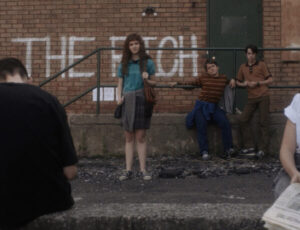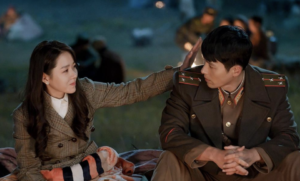In 2005, Hurricane Katrina struck New Orleans and caused such devastation that the city is still feeling the effects today. Directors Carl Deal and Tia Lessin give viewers a first hand account of the storm’s impacts and the aftermath in Trouble the Water. We are given a unique perspective provided by two New Orlean’s residents Kimberly Roberts, an aspiring rapper, and her husband Scott, who Deal and Lessin’s team found two weeks after the hurricane struck. We follow them around for a year after the storm, learning how they survived, rescued others and how they are attempting to rebuild their lives in the ruins of their city. Their experiences also highlight issues of race and class and give viewers a first hand look at the failure of government bureaucracy to protect and serve its people.
The entire film feels like a personal diary, with large portions, particularly at the beginning, made up of Kim Roberts’ home video of her neighbourhood before and during the storm. The film splices together this footage with news reports, and footage shot later by the filmmakers and the Roberts family. It is these personal elements that give Trouble the Water such power. Rather than be an overarching look at the effects of Katrina, government response and citizen struggles, it instead takes us to the ground to look at a couple fighting to survive, and to save others. The Roberts’, like many of New Orleans’s residents, could not afford to leave the city. Instead, they tested their luck and stayed put, hiding out in their attic as the levees failed and the waters rose.
The film is a fascinating look at class and privilege in New Orleans. Despite numerous evacuation warnings, city officials never organized public transport to remove citizens without access to cars, or the cash to leave, thus leaving the poor stranded. Although the film is mainly shown from the perspective of the Roberts’, we occasionally get to hear the opinion of government workers and the National Guard, particularly around issues of contention. Once the storm had eased the Roberts’ wandered looking for shelter. They headed directly to the local US Naval base in hopes of finding refuge. Scott describes how the soldiers held them and the others who gathered there at gunpoint, refusing them entry. When asked about it, those working the naval base describe a peaceful interaction, in which they were simply protecting government resources. The statement is strikingly cold. In times of need, are not government resources meant to aid the people? To turn people without food and shelter away when there were resources available after the wake of a hurricane is unconscionable. Those who stayed in the city were left on their own, something made painfully clear in a series of haunting 911 calls Deal and Lessin sourced. The calls were of people trapped in their houses pleading for help, only to be told that there were no plans for rescue operations.
The film constantly goes back to the point: would this have happened if the hurricane struck an area made up of mostly middle class whites? How would the aid have been different? In the film’s conclusion we see that while the majority of New Orleans white residents have returned to their homes, the majority of blacks were still displaced, their former neighbourhoods, such as New Orleans’ 9th Ward were still in ruins a year afterwards. Trouble the Water opens us up to an experience often overlooked in news and media, what it is like to be black and poor in America.







